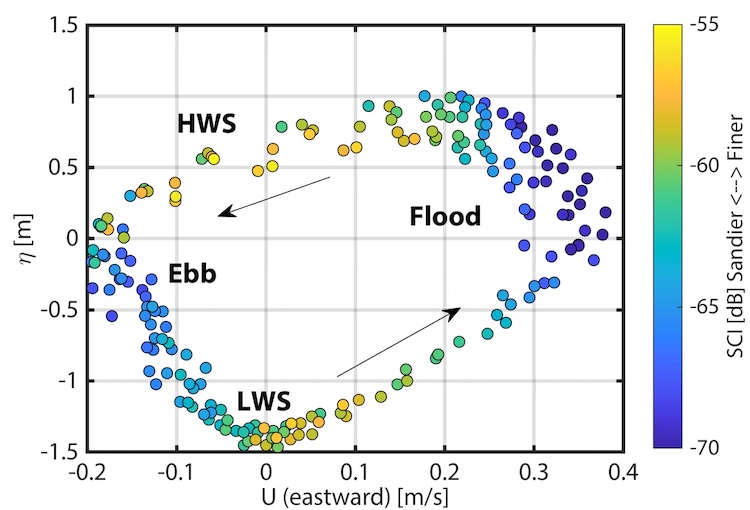S.G. Pearson1,2*, R. Verney3, H.C.M. Hendricks1,2, D. Tran3, M. Jacquet3, Z.B. Wang2,1 and B.C. v. Prooijen11
1 Delft University of Technology,
2 Deltares
3 IFREMER
Introduction
Estimating the composition of suspended particulate matter (SPM) is essential to understanding and managing estuaries and coastal environments where both sand and mud are present. Optical and acoustic backscatter differ for suspended sand and mud, which makes it possible to estimate the relative sediment composition in mixed suspensions by using paired optical and acoustic instruments. We derive a sediment composition index (SCI) for mixed sand-mud suspensions via theory and laboratory experiments, and then apply it to in situ measurements from Ameland ebb-tidal delta (the Netherlands).
Methods
SCI is derived from the difference between optical and acoustic backscatter signals. This relationship was validated in a series of laboratory experiments where we found that SCI is negatively correlated with increasing relative sand content. Field measurements of hydrodynamics and suspended sediment at Ameland Inlet were obtained from August 29th to October 9th, 2017 as part of the Kustgenese 2.0 project. Using these data, we calculate SCI and put it into context with local hydrodynamics and seabed characteristics.
Results
In periods where wave influence is negligible, SCI is highly cyclical (Figure 1). SCI is lowest on Ameland ebb-tidal delta at flood tide when high bed shear stress can resuspend sand from the local seabed and due to the lower turbidity of water from the North Sea. SCI is slightly higher at ebb tide due to reduced sand suspension under lower velocities, and due to the advection of mud from the Wadden Sea. SCI is highest at slack water when local sand falls out of suspension, but mud remains. In periods with strong wave action, SCI is reduced by suspension of local sand.
Using SCI to estimate relative proportions of suspended sand and mud reduces the ambiguity of suspended sediment measurements in mixed-sediment environments. The index gives greater insight into the sediment dynamics of Ameland ebb-tidal delta, highlighting the presence of mud in an otherwise sandy setting. This index also provides valuable insights for the planning and analysis of future field measurements.

Figure 1: Sediment Composition Index (SCI) on Ameland ebb-tidal delta during a period with few waves (Sept 21-25, 2017) as a function of water level and current velocity. Lighter colours correspond to 30-minute bursts with a relatively stronger optical backscatter (and hence dominated by suspended mud), while darker colours correspond to bursts with a relatively stronger acoustic backscatter (and hence dominated by suspended sand).
I. Surname1*, F.N. Another-Surname2 , Y. Next-Surname2
1 University Name, Country; 2 Organization Name, Country
* Corresponding author: mail.name@organization.org


